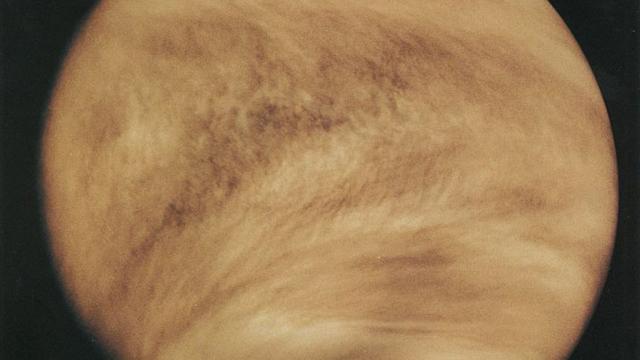A team of scientists modelling the Venusian atmosphere found data that could help explain the perplexing chemistry of the planet’s clouds. The findings further the possibility of life existing in Venus’s atmosphere, a still-controversial idea that will be investigated by several planned missions to the scorching planet.
Venus is the second planet from the Sun, which makes it a hell of a lot hotter than Earth. Besides the planet’s heat, Venus is an arid, rocky wasteland dominated by volcanoes and toxic sulfuric acid clouds. That cloud layer — about 19 km thick — shrouds the planet’s surface from Earth-based observers most of the time, and recently it has been in the spotlight as a possible hiding place of alien life.
The recent research modelled those clouds in greater depth, and the scientists found that the clouds on the planet aren’t fully composed of sulfuric acid but have some amount of ammonium salt slurries mixed in. The team’s study was published in the Proceedings of the National Academy of Sciences.
“Our model predicts that the clouds are not entirely made of concentrated sulfuric acid, but that the cloud droplets are partially neutralised. Our model postulates that the compound that neutralizes the acid in the clouds is ammonia,” said Janusz Petkowski, an astrobiologist at MIT and a co-author of the recent study, in an email. “The source of ammonia is unknown, but could be the result of biological production of ammonia in cloud droplets. As a result of the neutralization of the acid, the clouds are no more acidic than some extreme terrestrial environments that harbour life.”
The recent work builds on highly publicized research published last year in Nature, which claimed to detect phosphine gas in the Venusian atmosphere. (The scientists behind the new paper were also among the authors of the phosphine paper.) Phosphine is produced by microorganisms that don’t need oxygen to survive, so the presence of the gas was a surprising, exciting sign that something biological might be happening in those clouds. The finding was controversial; other researchers have said the supposed phosphine signal was really just sulphur dioxide, while others have suggested active volcanoes, not life, could be responsible.
“No life that we know of could survive in the Venus droplets,” said Sara Seager, a planetary scientist at MIT and a co-author of the new study, in an institute release. “But the point is, maybe some life is there, and is modifying its environment so that it is livable.”
The new paper didn’t focus on phosphine but rather some unexplained chemical signatures in Venus’s clouds. Years of observations have indicated more water vapour and sulphur dioxide than expected. Ammonia, the researchers thought, could explain those anomalies.
“Ammonia shouldn’t be on Venus,” Seager added. “It has hydrogen attached to it, and there’s very little hydrogen around. Any gas that doesn’t belong in the context of its environment is automatically suspicious for being made by life.”

The models indicated that, if microorganisms were on Venus and producing ammonia, oxygen would be released as a byproduct. Furthermore, the ammonia (which is basic) would neutralise the droplets of sulfuric acid in the clouds, making them somewhat habitable. While this work was all done with models, future space probe missions could help us get some answers about what’s really happening in the clouds.
Those missions are NASA’s VERITAS and DAVINCI+ missions, the ESA’s EnVision orbiter, and (maybe) the proposed, privately funded Venus Life Finder Missions, which Seager and Petkowski are working on. The latter is the only one with the fundamental purpose of investigating the possibility of alien life on Venus, but the space agency missions will likely glean some information on the subject as well. Of those three, DAVINCI+ is the only mission that will actually enter Venus’s atmosphere and sample it as the spacecraft descends to the planet’s surface.
If life of any kind were found off Earth — either fossilized on the surface of Mars, thriving in the clouds of Venus, or swimming in the ocean of an icy moon — it would be one of the most significant scientific discoveries of all time. But there’s a long, uncertain road ahead before any such claims can be made.
